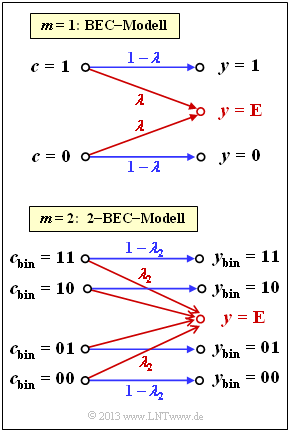Difference between revisions of "Aufgaben:Exercise 2.11Z: Erasure Channel for Symbols"
| Line 83: | Line 83: | ||
'''(5)''' Here one proceeds as follows: | '''(5)''' Here one proceeds as follows: | ||
| − | * | + | *With $\lambda = 0.0275 \Rightarrow \ \lambda_m = 0.2$, $20\%$ of the receiving symbols are <i>erasures</i>. |
| − | * | + | *The $2^8 = 256$ receiving symbols ($00000000$ ... $11111111$) are all equally likely. It follows: |
:$${\rm Pr}(y_{\rm bin} = 00000000) = \hspace{0.1cm}\text{...} \hspace{0.1cm}= {\rm Pr}(y_{\rm bin} = 11111111)= \frac{0.8}{256} \hspace{0.15cm}\underline{= 0.3125\%}\hspace{0.05cm}.$$ | :$${\rm Pr}(y_{\rm bin} = 00000000) = \hspace{0.1cm}\text{...} \hspace{0.1cm}= {\rm Pr}(y_{\rm bin} = 11111111)= \frac{0.8}{256} \hspace{0.15cm}\underline{= 0.3125\%}\hspace{0.05cm}.$$ | ||
{{ML-Fuß}} | {{ML-Fuß}} | ||
Revision as of 20:44, 5 September 2022
The channel model "Binary Erasure Channel" (BEC) describes a bit-level erasure channel:
- A binary symbol $0$ or $1$ is correctly transmitted with probability $1 - \lambda$ and marked as an erasure $\lambda$ with probability $\rm E$.
- In contrast to "Binary Symmetric Channel" (BSC), corruptions $(0 → 1, \ 1 → 0)$ cannot occur here.
A Reed–Solomon code is based on a Galois field ${\rm GF}(2^m)$ with integer $m$. Thus, each code symbol $c$ can be represented by $m$ bits . If one wants to apply the BEC–model here, one has to modify it to the $m\text{-BEC}$ model as shown in the diagram below for $m = 2$ :
- All code symbols – in binary representation $00, \ 01, \ 10, \ 11$ – are transmitted correctly with probability $1 - \lambda_2$ .
- Thus, the probability of an erased symbol is $\lambda_2$.
- Note that already a single erased bit leads to the erased received symbol $y = \rm E$ .
Hints:
- This exercise belongs to the chapter "Reed–Solomon Decoding at the Erasure Channel".
- For a code based on ${\rm GF}(2^m)$ the outlined $2$ BEC model is to be extended to $m$ BEC.
- The erasure probability of this model is then denoted by $\lambda_m$ .
- For the first subtasks, always $\lambda = 0.2$ for the erasure probability of the basic model according to the upper graph.
Questions
Solution
- $$\ {\rm Pr}(y = {\rm E}) = \lambda \ \underline{= 20\%}.$$
Since code symbols $0$ and $1$ are equally likely, we obtain ${\rm Pr}(y = 0) \ \underline{= 40\%}$ and ${\rm Pr}(y = 1) \ \underline{= 40\%}$ for their probabilities.
(2) Without limiting generality, we assume the code symbol $c_{\rm binary} = $ "$00$" to solve this exercise.
- According to the 2 BEC model, the receive symbol $y_{\rm binary}$ can then be either "$00$" or canceled $(\rm E)$ and it holds:
- $${\rm Pr}(y_{\rm bin} = "00"\hspace{0.05cm} |\hspace{0.05cm} c_{\rm bin} = "00") \hspace{-0.15cm} \ = \ \hspace{-0.15cm} ( 1 - \lambda)^2 = 0.8^2 = 0.64 = 1 - \lambda_2\hspace{0.3cm} \Rightarrow \hspace{0.3cm} \lambda_2 \hspace{-0.15cm} \ = \ \hspace{-0.15cm} 1 - ( 1 - \lambda)^2 \hspace{0.15cm}\underline{= 36\%}\hspace{0.05cm}. $$
- This assumes that an erasure is avoided only if neither of the two bits has been erased.
(3) The $\rm RSC \, (255, \, 223, \, 33)_{256}$ is based on the Galois field $\rm GF(256) = GF(2^8) \ \Rightarrow \ \it m = \rm 8$. The result of subtask (2) must now be adapted to this case. For the $8$ BEC holds:
- $$1 - \lambda_8 = ( 1 - \lambda)^8 = 0.8^8 \approx 0.168 \hspace{0.3cm} \Rightarrow \hspace{0.3cm} \lambda_m = \lambda_8 \hspace{0.15cm}\underline{\approx 83.2\%}\hspace{0.05cm}. $$
(4) From the condition $\lambda_m ≤ 0.2$ it follows directly $1 - \lambda_m ≥ 0.8$. From this follows further:
- $$( 1 - \lambda)^8 \ge 0.8 \hspace{0.3cm} \Rightarrow \hspace{0.3cm} 1 - \lambda \ge 0.8^{0.125} \approx 0.9725 \hspace{0.3cm} \Rightarrow \hspace{0.3cm}\lambda \hspace{0.15cm} \underline{\le 2.75\%}\hspace{0.05cm}.$$
(5) Here one proceeds as follows:
- With $\lambda = 0.0275 \Rightarrow \ \lambda_m = 0.2$, $20\%$ of the receiving symbols are erasures.
- The $2^8 = 256$ receiving symbols ($00000000$ ... $11111111$) are all equally likely. It follows:
- $${\rm Pr}(y_{\rm bin} = 00000000) = \hspace{0.1cm}\text{...} \hspace{0.1cm}= {\rm Pr}(y_{\rm bin} = 11111111)= \frac{0.8}{256} \hspace{0.15cm}\underline{= 0.3125\%}\hspace{0.05cm}.$$
